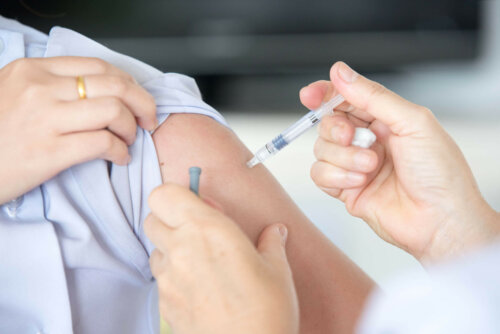4 Types of Injections You Should Know About

There are four types of injections and we classify them according to the route of administration. Injectable drugs are of the parenteral type and come in two types of glass containers: ampoules and vials.
Ampoules are a closed system, have long necks and a constriction at their base. Once you break the opening, or the “neck”, you can easily extract the drug.
Vials are a closed system, have a short neck and a hard plastic stopper lined with metal. You must inject a volume of air equal to the volume of the substance to extract in order to extract its contents.
The drug may be ready for administration as it is or might require another substance to mix with it. Here are the four types of injections as well as the specific characteristics of each one.

Medical professionals use the intravenous route for the administration of drugs in the following cases:
- Emergency situations
- Serotherapy
- Diluted drugs
This is because it’s the fastest route as the absorption of the medication is immediate.
Find out more about Self-Injectable Adrenaline: How to Use It
2. Intradermal injections
This is one of the types of injections used to perform diagnostic tests, skin tests such as allergy tests, and to administer local anesthetics.
In intradermal injections, they must introduce an amount of medication equal to, or less than, 0.3 milliliters. They usually do it with a 1-milliliter syringe or with a short bevel needle, which is usually orange or clear.
One can apply it to parts of the shoulder, the central area of the inner forearm, or the upper mid-back.
Procedure for intradermal injections
One hand tightens the skin of the area to inject and the other introduces the needle, almost parallel to the skin and with the bevel upwards. The medication forms a blister. Finally, they remove the needle without putting pressure on the blister.
Read about The Flu Vaccine
3. Subcutaneous types of injections
This type of injection introduces the medication into the subcutaneous tissue. The most commonly used drugs by this route are:
- Vaccines
- Heparins
- Insulin
The volume to administer varies between 1.5 and 2 milliliters with syringes of 1 or 2 milliliters and an orange medium bevel needle. Furthermore, it’s a slow absorption route and the most used areas are the external face of the arm, anterior face of the thigh, as well as the abdomen and the scapular area of the back.
Procedure
After disinfecting the area of application, the medical professional takes a fold of skin. They then insert the needle at a 45-degree angle — with the bevel of the needle facing upwards. They must pull the plunger to verify they haven’t punctured a blood vessel.
However, the angle changes for the administration of heparin. Thus, it’s important to remind the patient not to touch or press the puncture site in order to avoid bruising.
4. Intramuscular injections

This type of injection is for the administration of medication into the muscle. The most common medications for this route are vaccines and other drugs such as analgesics, anti-inflammatory drugs, corticosteroids, and antibiotics.
It’s a faster absorption route than the subcutaneous one. In addition, its effect appears in about 15 minutes. The volume to inject is less than 15 milliliters and the syringe is two or five milliliters with a medium bevel needle and a green color for adults.
The most common areas for administration are the upper outer quadrant of the gluteus, the deltoid, and the vastus lateralis of the leg.
Procedure
For the administration of these injections, the medical personnel inserts a needle directly into the muscle at a 90-degree angle. Then they adapt the loaded syringe and pull the plunger back to ensure they didn’t puncture a capillary.
They then innoculate the medication slowly, as it’s a painful route. This is due to the fact that the muscle fibers are stuck together and detach when the liquid goes in, thus causing pain. Then, the medical personnel removes both the syringe and needle at the same time when finished.
The types of injections depend on the drug and the situation
Finally, as you could see throughout this article, the routes of administration of parenteral drugs are multiple and depend on several factors. You’re a little more informed now about these procedures and so you’ll know exactly what’s going on the next time you need to go to the hospital!
All cited sources were thoroughly reviewed by our team to ensure their quality, reliability, currency, and validity. The bibliography of this article was considered reliable and of academic or scientific accuracy.
- Rimbaud, P. E., & Chavarría, L. R. (2005). Métodos de sujeción y aplicación de inyectables. Bio-Nica.Inf. https://doi.org/10.1016/j.foreco.2008.12.001
- Edwin, P., & Ambulódegui, S. (2012). Manual de Inyectables y Venoclisis. Administracion Parenatal. https://doi.org/10.1109/TCST.2014.2301840
- Serrano-Grau, P., Mascaró-Galy, J. M., Iranzo, P., Navarra, E., & Ferrando, J. (2007). Productos de relleno inyectables en dermocosmética. Tipos y efectos secundarios. Medicina Cutanea Ibero-Latino-Americana.
This text is provided for informational purposes only and does not replace consultation with a professional. If in doubt, consult your specialist.








